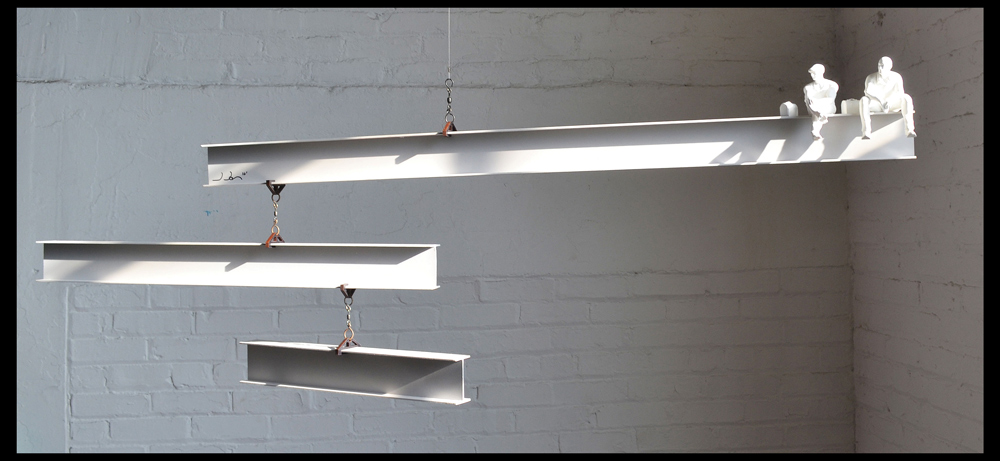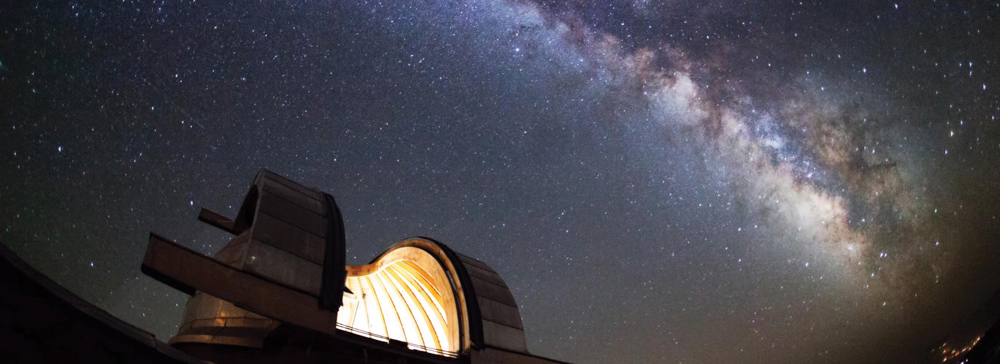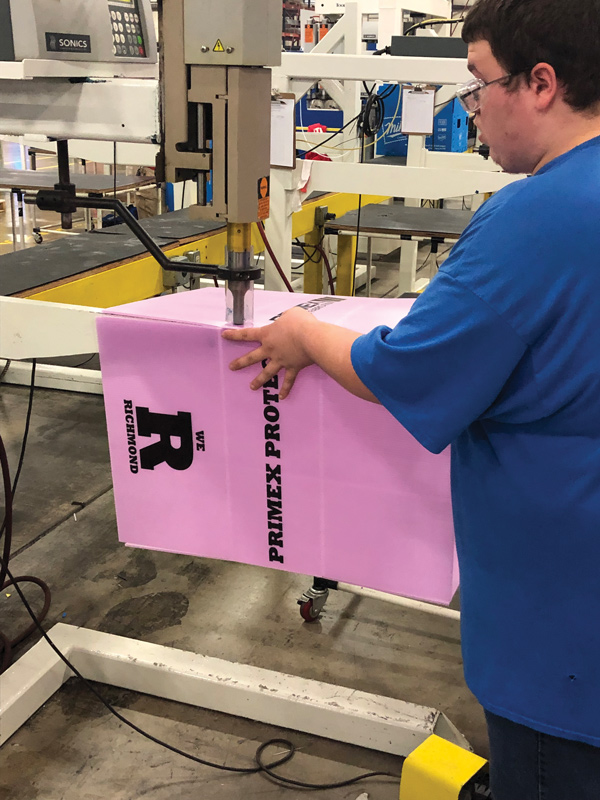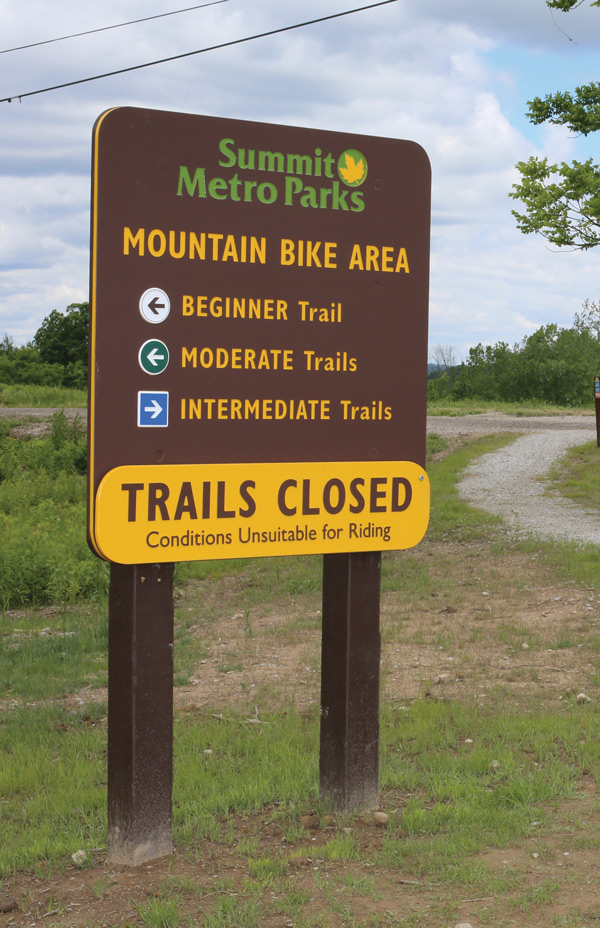
Experienced in set and prop building for theatrical, television and film productions as well as furniture-making, Jones had used SINTRA for many years to create signage. “I wanted to find a material that would create the illusion of an I-beam but would be lightweight,” said Jones. “I had used SINTRA for display work. It’s flat, clean and perfect for applying vinyl graphics; plus, it can be drilled easily. It’s consistent in color and density.”
As a high-performance moderately expanded PVC board, SINTRA is a solution for graphic display projects that require high quality materials. SINTRA is available with premium bright-white surfaces and in a broad range of colors in gauges ranging from 1 mm to 12.7 mm and in standard sheet sizes ranging from 48″ x 96″ up to 2 meters x 120.” Jones purchased SINTRA graphic display board for this project from the Greensboro, NC, USA location of distributor Piedmont Plastics.
Jones has been following his inspiration to create mobiles since he first saw the untitled mobile designed by artist Alexander Calder for The National Gallery of Art in Washington, D.C., USA during a family trip in 2006. “It was Calder’s ability to use simple material to create work that was so simple in structure but so complex in its language and visual effect,” said Jones. “The massive mobile weighs 920 pounds yet it seems to be floating. It had a profound effect on me.”
Jones began creating “Calder-inspired” mobiles from SINTRA in 2007 for residential display as a part-time pursuit and teaching mobile-making classes. Creating mobiles grew into a full-time business for Jones and his wife, Naomi, with the addition of Modern Mobiles — mobile-making kits that allow anyone to build their own repositionable mobile.
“When I taught classes on mobile-making, students would ask if I could make something that they could put together,” said Jones. “So I developed a slider and made pieces to attach from SINTRA. It was a very available material and possessed all of the properties that we needed. People were inquisitive about mobiles and wanted to build their own. The aesthetic we provide with the kits bumps it up a notch or two. We just needed to find the right material. That was SINTRA.”

“With the mobile kits, we needed to be able to drill a hole in the edge of the material to accept the rod,” said Jones. “We tried other materials and went back to SINTRA. For the sculptures, we heat it up and shape it. SINTRA has been a terrific product for me. Its light weight has been critical for the sculptures because the beams are designed to float almost like they are weightless. I couldn’t make them out of steel.”
Jones builds the I-beams by cutting strips from 4-by-8-foot sheets of 6 mm SINTRA in the gray color (although he has painted some beams red). The beams are constructed just like steel I-beams with a top plate and a bottom plate, which are both grooved to accept a vertical piece that is secured with epoxy. Jones uses a combination of model-making computer software and gaming animation to create the characters, which are 3-D printed out of ABS plastic.
As for humor, Jones said, “I thought that it was funny to see a guy walking off the end of the beam looking at his cell phone. There is an instant connection with the audience. It’s also a very contemporary distraction.”
Jones has created eight I-beam sculptures in varying sizes for both public and corporate display. The first was selected in 2016 by the North Carolina Art Council as a public installation at the Piedmont Triad International Airport in Guilford County, NC, USA. His latest work, entitled “Beams,” is displayed at Artplex Gallery in Los Angeles, CA, USA. www.3acompositesusa.com/display.

“Not only are we proud to announce the opening of this newly constructed hotel, but we are also thrilled to open it under our company’s new name, Radisson Hotel Group,” said Aly El-Bassuni, senior vice president, franchise operations, Americas, Radisson Hotel Group. “This hotel is a wonderful representation of the Gen 4 Country Inn & Suites by Radisson, which will provide a genuine experience that allows guests to relax and create memorable moments during their stay.” www.alumanate.com.

In footwear, a major component of the outsole is ethylene-vinyl acetate (EVA), a substance that makes for a rubber-like texture and provides durability. As conventional EVA derives from fossil fuels, it contributes to carbon emissions. In contrast, Braskem’s I’m green™ bio-based EVA is made from biofuel obtained from sugar cane. This highly efficient crop is carbon-negative: Sugar cane consumes CO2 and extracts clean oxygen. I’m green™ bio-based EVA is an earth-friendly alternative to conventional EVA that provides the same comfort and longevity.
Given its commitments, TOMS is excited to add the I’m green bio-based EVA from Braskem to its framework of earth-friendly materials and presents new Earthwise styles featuring the carbon-negative EVA. One of these styles is the tie-dye plant dye capsule — a shoe that already features earth-friendly elements in most of its components. In addition to the outsole being made with I’m green bio-based EVA, the TENCELT Lyocell lining is dyed through a chemical-free process using botanical pigments and the Ortholite insole is comprised of 26 percent eco content. www.braskem.com.

Holographic light-guiding films for diffractive films in telescopes must meet numerous requirements. High optical quality and very good transparency is a given, but there are also other considerations. For example, the material must be versatile enough to be customized to meet the specifications of different instruments. Processability is critical: It must be highly uniform to ensure it is easy to reproduce and easy to handle without the need for chemical pretreatment or postprocessing.
Bayfol HX holographic films from Covestro gave INAF a highly efficient way to analyze the stars of our universe. INAF used customized Bayfol HX films to produce the diffraction grating for a number of different instruments in five very different high-performance telescopes. The material offers high uniformity, enabling INAF to reduce the complexity of the analyzing instruments. The material has performed well, maintaining its very high optical quality and transparency for more than eight years. https://solutions.covestro.com.

The gate was removed in September 2014 to perform inspection of gate wheel assembly and bearings. Several of the wheels had either stopped working or fallen off due to corrosion and lack of lubrication. The remaining bearings had excessive clearance due to wear. New stainless steel sleeves were fabricated and welded onto the gate wheel stub shafts. New composite greaseless bushings supplied by Columbia Industrial Products were installed to replace the failed bearings.
A year later, the tunnel gate was removed to inspect the condition of CIP Composite Bushings. Wheels were removed to inspect and document the condition of new stainless steel sleeves and CIP bushings. Sleeves and bushings were found to be in excellent condition and did not warrant further disassembly. Wheels were checked to make sure they were not bound up on the stainless steel sleeves and continue to rotate. All components look great after one year of service. www.cipcomposites.com.

Shortly after the face shields began to ship, Primex realized they needed to increase manufacturing capacity, so they engaged three other Richmond companies — B & F Plastics, Ahaus Tool and Hoosier Container — to help with production and shipping of the 30,000 face shields per day they are now delivering. Hoosier produced 35,000 shipping boxes for Primex in two days. In addition, Primex involved some competitors including Barber Packaging of Bangor, MI, USA and Special Design Products of Columbus, OH, USA in the business.
“We’ve increased our own workforce from 73 to 90 during this period and we’re helping our partners in this venture avoid the layoffs that many manufacturers are experiencing during the pandemic,” said Borgsdorf. Barber’s Luke Barber agreed, “Since we were heavily dependent on the automotive industry, we took a big hit when the pandemic started. But the business we got from Primex allowed us to keep our workforce busy and even now has helped us get some nonautomotive jobs.” Between die cutting, assembly and shipping, the five companies are helping to meet the extraordinary demand for the PrimexProtect products. Altogether, there are nearly 200 workers involved in the effort.
The face shields were just the beginning. Since April, the PrimexProtect line has expanded to include social distancing barriers, golf cart dividers, signage, retail barriers and medical waste containers, all made in the United States. “Our people are constantly asking what they can do to help. It has been a remarkable journey and we’re immensely proud of the way our employees and partners are responding,” said Borgsdorf. www.primexfabrication.com.

Summit Metro Park’s signs were originally made from Douglas fir lumber that often needed to be primed and stained. In 2015, the signs were replaced with King ColorCore®, a high-density polyethylene (HDPE) material that is environmentally stabilized and developed to withstand the harshest outdoor conditions. It will not rust, delaminate or rot when exposed to humidity or water. The new signs are low maintenance and will never need painting or refinishing.
